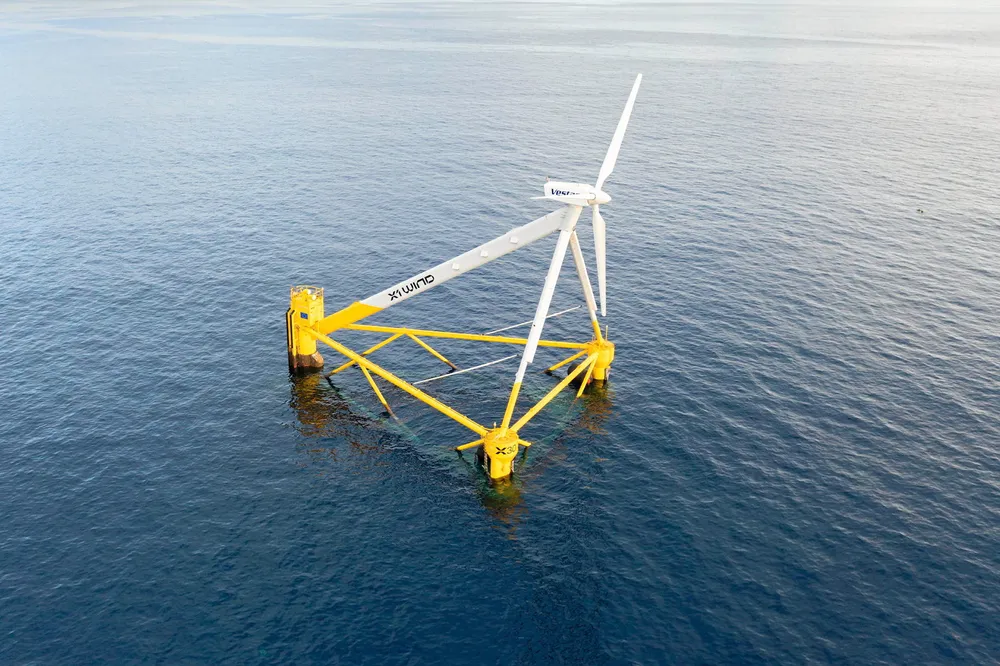X1 Wind and Technip Energies secure EU funding to scale 'disruptive' floating concept
Downwind floating wind concept promises lower LCOE, reduced seabed footprint and faster disconnect

A consortium led by floating wind innovator X1 Wind and contracting giant Technip Energies has secured a €13.4m ($14.3m) grant from the European Commission to support the deployment and subsequent scaling up of a 6MW floating wind platform, to be called the 'X90', at a test site in the Mediterranean.
The project, called NextFloat+, aims to enhance the competitiveness and scalability of floating wind technology by developing an updated version of X1's weathervaning 'downwind' offshore wind turbine configuration.
The X90 will test a design that, like earlier projects, uses the downwind configuration with tension leg platform (TLP) and single point mooring technologies.
According to X1 Wind, the funding will facilitate the scaling-up of this technology to more than 20MW capacity, furthering its commercial viability and thereby accelerating the roll out.
The grant was awarded under the European Commission’s Innovation Fund which supports the industrialisation of floating wind.
The NextFloat project was first launched in Paris on November 2022 with Technip Energies as project coordinator and the backing of other partners such as Naturgy, 2B Energy, and Hellenic Cables.
The initial project received €16m of backing under the EU’s Horizon Europe programme, supplemented by private funding from partners and shareholders.
More funding was secured through the French Government through ADEME Investissement, a state-owned French financier of innovative infrastructure projects.
X1 Wind CEO and co-founder Alex Raventos said the award will “provide an opportunity to drive substantial improvements in the competitiveness of floating wind as we prepare for long-term mass deployment in locations around the world.”
The NextFloat+ Project will build on the findings of X1 Wind’s PivotBuoy Project, which demonstrated the innovative technology through a scaled down prototype in the Canary Islands.
Self-aligning
The technology allows the turbine to align passively with the wind, offering continually optimised positioning as well as scope for using longer, lighter blades and allowing rapid disconnection and connection in maintenance scenarios.
The new project will introduce additional innovations to reduce the LCOE of floating wind and its environmental impact, including a patented quick-connector system and the installation of a bio-boosting system, according to a statement by X1 Wind.
“We are thrilled to announce our selection for the NextFloat+ project, an initiative that seeks to propel the pre-commercial phase of a floating wind project and showcase our capacity to facilitate commercial-scale projects in Europe and across the globe," commented Willy Gauttier, vice-president of Technip Energies’ floating offshore wind business unit.
"This project presents a singular opportunity to expedite the advancement of sustainable energy solutions and foster the expansion of the floating wind industry.”
The Innovation Fund is financed by EU Emissions Trading System revenues, a ‘cap and trade’ system to reduce emissions via a carbon market. It focuses on highly innovative clean technologies and big flagship projects with European added value that can bring significant emission reductions.
Based in Barcelona, X1 Wind was co-founded by Carlos Casanovas and sought to combine single point mooring with the company's on PivotBuoy system for a downwind floating wind configuration.
Technip Energies acquired a 16.3% stake in X1 Wind in 2022 after being attracted to what it called an "innovative and disruptive offshore wind turbine floater with major environmental and operational benefits".
The Paris-based engineering and technology giant said the design allows for a lighter floater design with a significantly reduced steel requirement and for a more efficient and restricted mooring system minimising the impact on seabed.
Technip Energies made it clear back that it would collaborate with X1 Wind on the development of a first commercial-scale demonstrator, as well as the related industrialisation and commercialisation plans of the technology.